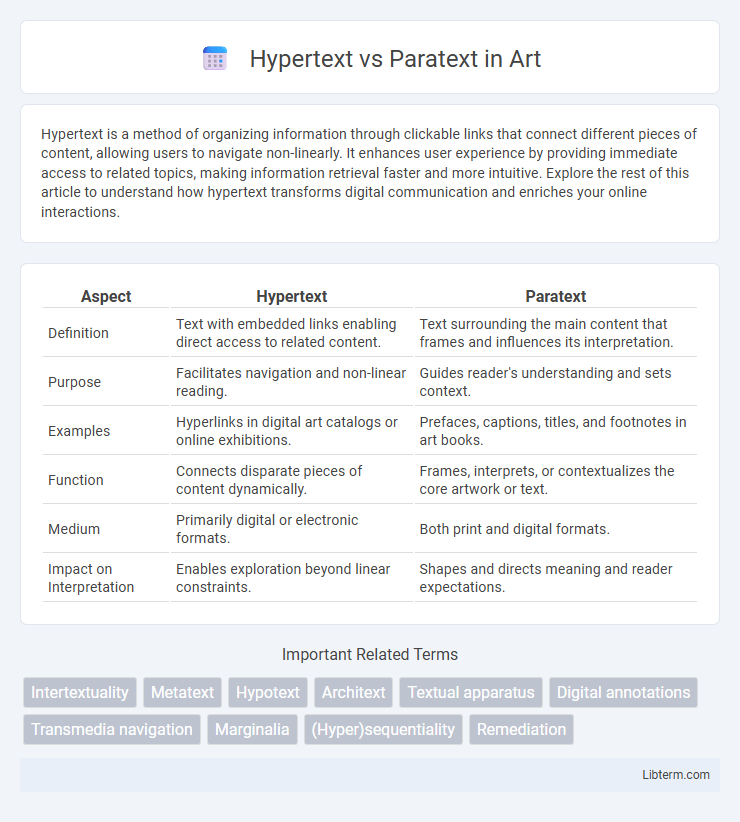Hypertext is a method of organizing information through clickable links that connect different pieces of content, allowing users to navigate non-linearly. It enhances user experience by providing immediate access to related topics, making information retrieval faster and more intuitive. Explore the rest of this article to understand how hypertext transforms digital communication and enriches your online interactions.
Table of Comparison
| Aspect | Hypertext | Paratext |
|---|---|---|
| Definition | Text with embedded links enabling direct access to related content. | Text surrounding the main content that frames and influences its interpretation. |
| Purpose | Facilitates navigation and non-linear reading. | Guides reader's understanding and sets context. |
| Examples | Hyperlinks in digital art catalogs or online exhibitions. | Prefaces, captions, titles, and footnotes in art books. |
| Function | Connects disparate pieces of content dynamically. | Frames, interprets, or contextualizes the core artwork or text. |
| Medium | Primarily digital or electronic formats. | Both print and digital formats. |
| Impact on Interpretation | Enables exploration beyond linear constraints. | Shapes and directs meaning and reader expectations. |
Understanding Hypertext: Definition and Evolution
Hypertext is a system of organizing and linking text that allows users to navigate between related pieces of information through clickable links, creating a non-linear reading experience. Originating from Vannevar Bush's concept of the memex and later developed by Ted Nelson in the 1960s, hypertext evolved with the advent of the World Wide Web, fundamentally transforming digital communication and information access. Its defining characteristic is the ability to present information dynamically, enabling users to explore content through interconnected nodes rather than sequential, linear text.
What is Paratext? Exploring Its Core Concepts
Paratext refers to the supplementary materials surrounding the main text, including elements like titles, prefaces, footnotes, and indexes that influence how readers interpret the core content. These components serve as a threshold, guiding understanding and framing the primary narrative by providing context, authorial intent, and interpretive cues. Gerard Genette's theory highlights paratexts as integral to the reading experience, shaping the reception and meaning of hypertext or traditional texts alike.
Historical Context: The Origins of Hypertext and Paratext
Hypertext originated in the 1960s with Ted Nelson's Project Xanadu, designed to create a non-linear method for organizing and accessing information electronically, revolutionizing digital reading and writing. Paratext, a term popularized by Gerard Genette in the 1980s, refers to the textual elements surrounding the main text, such as titles, prefaces, and footnotes, shaping readers' interpretations and contextualizing the content. The historical evolution of hypertext reflects advancements in computing, while paratext roots in literary theory emphasize the framing devices integral to textual meaning.
Key Differences Between Hypertext and Paratext
Hypertext is a digital text format that allows direct access to linked information, enabling nonlinear navigation through clickable links embedded within the content. Paratext refers to supplementary materials surrounding the main text, such as introductions, footnotes, and forewords, which provide context but are not part of the primary narrative. The key difference lies in hypertext's interactive, connective role within the text, while paratext functions as contextual or auxiliary information framing the primary content.
Functions and Roles in Digital Media
Hypertext functions as the core interactive system in digital media, enabling non-linear navigation through linked content that enhances user engagement and information retrieval. Paratext serves a complementary role by providing contextual frameworks such as metadata, navigation menus, and annotations that guide interpretation and structure user experience. Together, hypertext and paratext shape how digital content is accessed, understood, and contextualized, optimizing both usability and meaning in digital environments.
Hypertext in Modern Web Design
Hypertext in modern web design enables seamless navigation and interactivity by linking diverse content through embedded hyperlinks, enhancing user engagement and information accessibility. It supports responsive design principles by allowing dynamic content updates and integrating multimedia elements, which improves user experience across devices. Utilizing hypertext structures facilitates SEO optimization, increasing content discoverability and driving organic traffic to websites.
Paratextual Elements in Literature and Media
Paratextual elements in literature and media serve as the threshold between the content and the audience, providing essential context, guidance, and interpretative cues that shape the reception of the hypertext. These elements include titles, prefaces, footnotes, illustrations, and cover designs, which function to frame the main text, influencing reader expectations and enhancing comprehension. In digital media, paratextual components extend to metadata, hyperlinks, and user interface features, playing a crucial role in navigation and the overall interactive experience.
Impact on Reader Experience and Interpretation
Hypertext enhances reader experience by enabling nonlinear navigation through linked digital content, fostering active engagement and personalized interpretation. Paratext, including elements like titles, prefaces, and footnotes, frames the text and guides readers' understanding, shaping initial expectations and interpretive contexts. Together, hypertext and paratext influence how readers interact with and derive meaning from digital and printed texts, altering traditional reading pathways and comprehension processes.
Examples of Hypertext and Paratext in Practice
Hypertext is exemplified by online articles with clickable links that direct readers to related content, enabling non-linear navigation through interconnected information. Paratext includes book covers, prefaces, footnotes, and indexes, which provide context, interpretation, and additional details that frame the primary text for readers. Popular digital platforms like Wikipedia utilize hypertext through embedded hyperlinks, while its introductory summaries and citation lists function as paratextual elements guiding user understanding.
Future Trends: Hypertext vs. Paratext in Digital Communication
Future trends in digital communication highlight the growing integration of hypertext and paratext to enhance user engagement and information retrieval. Hypertext evolves with AI-driven contextual linking, enabling seamless navigation across complex data sets, while paratext adapts through dynamic metadata and customizable interfaces that guide interpretation and user experience. Combined advancements will foster more intuitive, personalized digital environments, bridging content and context for enriched communication.
Hypertext Infographic

 libterm.com
libterm.com